The blog of cooking-ez.com
Double cooking of vegetables
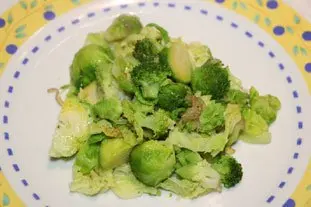
When you cook vegetables, it's not easy to capture and preserve the flavours.
It is easy to undercook, but you can make up for it, or overcook, and then it is unfortunately a bit cooked (in the sense of "ruined").
But above all, how to get the maximum of the taste of the vegetable in the pan, then in your plate, and not in the air of the kitchen or the cooking water?
It's not easy, many cooks will tell you that cooking meat is relatively simple, but that vegetables...
It is easy to undercook, but you can make up for it, or overcook, and then it is unfortunately a bit cooked (in the sense of "ruined").
But above all, how to get the maximum of the taste of the vegetable in the pan, then in your plate, and not in the air of the kitchen or the cooking water?
It's not easy, many cooks will tell you that cooking meat is relatively simple, but that vegetables...
18K 27 4.1
Last modified on: July 12th 2019
Keywords for this post:CookingVegetablesBoiling waterSaltDoubleTipDouble cooking of vegetables
Add to all this that, in addition, it is difficult to generalize, that is to say that for such and such a vegetable it is better to do like this while for others it is better to do like that.
But rather than discuss it, I'll take an example with Brussels sprouts, which are tasty vegetables (but that it is easy to completely mess them up by overcooking them, like at the canteen when you were little).
Peel, cut in 4 if the cabbages are big to have pieces not bigger than a sugar cube, and wash with water.
2) First cooking
The cabbages are plunged into a large volume of salted water (1 tablespoon of coarse salt per litre of water), and cooked until they are tender, but not melting, it is very important
3) Cool quickly
Remove the cabbages from the cooking water with a skimmer and plunge them into very cold water, to stop cooking immediately, then drain carefully.
Note that the cooking water at this point is no longer simple salt water, it is already starting to be a vegetable broth, and you should keep it in the fridge after cooling, for other cooking of other vegetables.
4) Second cooking
In a saucepan or a frying pan, heat a large knob of butter or a little olive oil, once hot, add a finely chopped shallot, salt and pepper and cook for 1 minute, without colouring. Then add the vegetables, well drained, and cook for 2 or 3 minutes, hardly more. Serve immediately.
If you don't know, or have never practiced, you might be very surprised by the delicate taste of the vegetables treated this way. Making for example a dish with 3 or 4 different vegetables, in season, with this method, will give you a rather simple dish, just vegetables, but also exceptional in taste and finesse.
- For the seasoning, just salt and pepper you have seen, but some finesse is quite possible, like a little fleur de sel just before serving, or a sophisticated pepper.
- Obviously, and as always, it is much better with seasonal vegetables.
To sum up: The next time you have vegetables to cook, try the double cooking, boiling salted water, then pass in shallot, or onion, sautéed in butter or olive oil.
Insoluble?
No, not exactly, in fact there is a method that gives very good results for almost all vegetables, it is the double cooking.How does it work?
The general principle is that we cook a first time in boiling salted water (cooking called"A l'anglaise", by the French), then a second cooking with a little fat, butter or oil for example according to your taste. This double cooking, even if it is a little longer, is the quasi insurance of a taste of the vegetable revealed and preserved.But rather than discuss it, I'll take an example with Brussels sprouts, which are tasty vegetables (but that it is easy to completely mess them up by overcooking them, like at the canteen when you were little).
The double cooking of Brussels sprouts
1) Peel and wash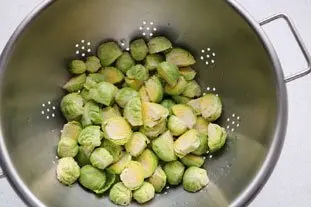
Peel, cut in 4 if the cabbages are big to have pieces not bigger than a sugar cube, and wash with water.
2) First cooking
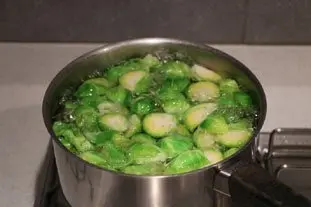
The cabbages are plunged into a large volume of salted water (1 tablespoon of coarse salt per litre of water), and cooked until they are tender, but not melting, it is very important
3) Cool quickly
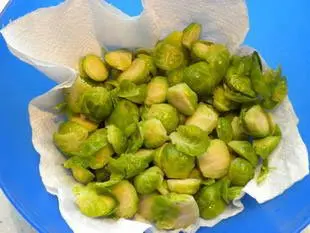
Remove the cabbages from the cooking water with a skimmer and plunge them into very cold water, to stop cooking immediately, then drain carefully.
Note that the cooking water at this point is no longer simple salt water, it is already starting to be a vegetable broth, and you should keep it in the fridge after cooling, for other cooking of other vegetables.
4) Second cooking
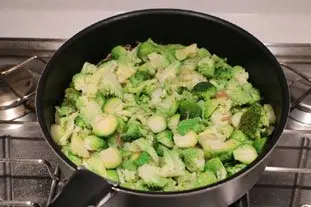
In a saucepan or a frying pan, heat a large knob of butter or a little olive oil, once hot, add a finely chopped shallot, salt and pepper and cook for 1 minute, without colouring. Then add the vegetables, well drained, and cook for 2 or 3 minutes, hardly more. Serve immediately.
If you don't know, or have never practiced, you might be very surprised by the delicate taste of the vegetables treated this way. Making for example a dish with 3 or 4 different vegetables, in season, with this method, will give you a rather simple dish, just vegetables, but also exceptional in taste and finesse.
Some more info-
For an even more delicate taste, use instead of boiling water, a vegetable or poultry stock.- For the seasoning, just salt and pepper you have seen, but some finesse is quite possible, like a little fleur de sel just before serving, or a sophisticated pepper.
- Obviously, and as always, it is much better with seasonal vegetables.
To sum up: The next time you have vegetables to cook, try the double cooking, boiling salted water, then pass in shallot, or onion, sautéed in butter or olive oil.
Lasts posts
Wipe meats and fish before cooking
When you want to cook meat or fish, there's a very simple yet very important step to take before you even start: It's to dry, or wipe, each side of the meat or fish, sometimes called "dabbing" or "sponging". But why? And how? Let me explain.1,5115 April 14th 2024
Toss the salad
When you've finished preparing a salad, green or otherwise, it's usually time to add the dressing and toss. It's often said to "toss the salad", which means to season and mix. Is it easy? Not so easy...2,8505 March 8th 2024
Half milk, half cream
In a multitude of recipes, savoury or sweet, milk is used as the main ingredient, or at least as the main liquid ingredient. Milk is used instead of water, for example, because milk contains a proportion of fat, which adds roundness and softness to the recipe. This mellowness is very pleasant on...2,690 February 27th 2024
Cutting soft cheeses
As you may have already noticed, when you have to use a "soft" cheese in a recipe - their exact name is "soft cheese" - such as Camembert, Munster or Mont d'or, it's not easy to make anything other than thick slices.2,8095 February 20th 2024
It's spinning too fast!
When you need to grate or slice vegetables, you generally use an electric machine that does all the work: a food processor, a mixer with a "slicer" extension or similar. Are these machines really suitable? Generally speaking, yes of course, but there's one criterion that often poses a problem,...5,7755 November 12th 2023
Other pages you may also like
Fruits which can ruin your jelly
There are many ways of making a fruit mousse, but one of the simplest is to prepare a fruit jelly (basically a fresh fruit coulis with gelatine) and then mix this jelly before it sets completely with whipped cream. The result is perfect for filling a charlotte, for example. But do beware;...68K4.0 March 6th 2013
What is the difference between bakery and patisserie?
This is a question that you may well have asked yourself and which I will attempt to answer. In France the two trades of "boulangerie" (bakery) and "pâtisserie" (patisserie and confectionery) have always been quite distinct, but where exactly do the boundaries lie? .119K 14.1 February 7th 2017
Candied fruits: don't get ripped off
Do you like candied fruit? You might like to nibble a handful or add it to a recipe, like a classic fruit cake or delicious Italian specialities like panettone or sicilian epiphany pie.53K 24.2 June 21th 2017
Unmoulding cakes while hot
When you make a cake, pound cake or whatever (what bakers call a "travel cake" because it's easy to carry around) you've most likely made a batter, either by hand or in a food processor, which you then pour into a buttered pan. It's a classic, and I've already talked to you about 2 or 3 tips on...32K4.6 February 6th 2021
Perpetual stock
It's something you have probably have done yourself: cooked or pre-cooked vegetables before adding them to a recipe. This is almost always done the same way: peel the chosen vegetables (carrots, for example), cut them up, boil them in salted water (using a tablespoon or so of coarse salt per litre),...23K5 November 22th 2016
Follow this page
If you are interested in this page, you can "follow" it, by entering your email address here. You will then receive a notification immediately each time the page is modified or a new comment is added. Please note that you will need to confirm this following.
Note: We'll never share your e-mail address with anyone else.
Alternatively: you can subscribe to the mailing list of cooling-ez.com , you will receive a e-mail for each new recipe published on the site.









